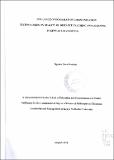| dc.description.abstract | Information Communication Technologies (ICTs) are varied. They include different types of network infrastructure that depend on internet connectivity which in turn allows access to various search engines. ICTs have transformed the way people live, work, do business and access education. With advent of ICTs, distance learning has become an alternative and supplement for face to face learning. This study investigated the influence of ICTs on quality of distance teaching and learning in Kenyan Universities. The study was guided by four objectives: to establish the influence of availability of ICTs infrastructure, to determine the influence of utilization of ICTs infrastructure, to investigate the influence of provision of institutional support on use of ICTs and to determine the influence of learner characteristics on use of ICTs. The study was based on Bruner's constructivist theory and Simonson's theory of equivalency. The study was guided by mixed methods research approach. Specifically, convergent parallel design was used. The target population was universities that offer programmes through open, distance and e-learning (ODeL) targeting ODeL directors, lecturers who taught ODeL students, ICT technical staff and ODeL students from the selected universities that offer programmes through this mode. A sample size comprised of (4) ODeL directors, (78) lecturers, ( 4) I CT technical staff and (15 6) 0 DeL students. Stratified, systematic and purposive sampling was used to sample the respondents. Among all the universities that offer ODeL programmes, four universities were purposively sampled for the study. Data was collected by use of document analysis guide, questionnaires and interview guide. Cronbach alpha correlation method was used to compute reliability co-efficient which was 0.8095 which was above 0.7 as expected in social sciences. To ensure reliability in qualitative data, interview guide with highly structured questions, with the same format and sequence of words was used for each participant. Descriptive statistics involving mainly frequencies, percentages and means were used to analyse the data. Logistics Regression, specifically Wald Test, was used to test the null hypotheses. Omnibus test of model coefficients and Hosmer and Lemeshow Tests were used to test the fitness of the models. Data was presented in graphs and tables. Analysis of quantitative data was done using Predictive Analytical Software (PAS) version 20.0. Qualitative data was coded and analysed in themes emerging from the narratives. From the findings, it was established that computers were the most available ICT hardware used in distance teaching and learning in the sampled universities. Despite availability of computers, it was established that video conferencing and audio-conferencing facilities were not available for distance teaching and learning. Universities use Learning Management Systems (LMS) and also online social networking tools to advance distance learning. The study revealed that the institutional support on use ofICTs was the most significant factor that influences quality of distance teaching and learning in selected Kenyan universities. It was concluded that availability of ICT infrastructure, utilization of ICT infrastructure, institutional support on the use of ICT and learner characteristics on the use of ICT were all significant when considered separately. However, when considered as a block, institutional support on use of JCT was the most significant. The study recommended that to enhance quality in ODeL, institutional support on use of ICTs in distance teaching and learning was very critical. | en_US |

